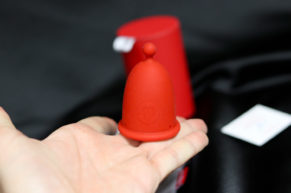These specific intimate aids are used by those women who do not want to use traditional intimate pads or tampons. Menstrual cups are made of medical grade silicone. This is due to its hypoallergenic properties, elasticity, colour fastness and easy and effective cleaning. The cup is usually inserted folded in half to sit well on the area around the cervix, where the gentle vacuum (created by the appropriate shape of the cup) makes it gently adhere.
Menstrual cup as the most ecological choice
You may have been dissatisfied with conventional menstrual aids for some time and menstruation is rather synonymous with discomfort and stress. Tampons often carry risks with them due to our internal pH and the bleaching chemicals they contain. Pads, on the other hand, are not very comfortable. Another problem that cannot be overlooked is the amount of unnecessary waste that we thus produce every month. The topic of waste and the environment can no longer be ignored nowadays, which is why more environmentally friendly alternatives are appearing on the market. One of these is the menstrual cup.
The cup – a reliable alternative
A menstrual cup is a hygienic device for women that safely captures menstrual blood. It is made of silicone, which makes it very practical and easy to wash. It can be used repeatedly – so there is no need to buy a new one every month. The great advantage of the silicone material is that it does not smell. The cup can be used just as an addition to other menstrual aids, or start using it as a complete alternative.
Ecological and economical
By being able to use the menstrual cup repeatedly, we noticeably reduce our waste production and do something good for nature. No more unnecessary extra waste. The cup is also worthwhile for economic reasons, as it lasts for several years thanks to its high-quality material. The initial investment is quickly recouped and we save money.
Convenient and discreet
Inserting the menstrual cup may take a little practice at first, but it is generally very comfortable to use. Once in place, it lasts up to 12 hours – but it depends on the intensity of the bleeding and the size of the cup. You don’t have to worry about it not being visible because, like a tampon, it is completely discreet. And most importantly, you’ll never run out. Soon you won’t be able to get enough of it. During menstruation, just wash the cup with warm water and at the end of the period, just boil or sterilize the cup. That’s all you need.
Which cup to choose?
There are usually two or three cup sizes available. In simple terms, the smallest size is suitable for women who have not yet given birth and have a light period, the medium size for women who have not given birth and have a medium or heavier period, and the largest cup size is especially appreciated by women who have already given birth and therefore have more stretched vaginal muscles.
The strength of the menstrual period and the stretch of the vaginal muscles therefore play an important role when choosing a menstrual cup. It is also possible to choose from different types of grips. Each “shank” can have a different shape: straight, scalloped, circular, etc. The stem is used for better handling at the beginning of the use of the cup. Later, when you learn to handle the cup, it can be cut off.
Cleaning the menstrual cup
There are several ways to clean the cup. It can be disinfected by boiling it or sterilising it in the microwave. For sterilisation, a special sterilisation cup can be useful to put the cup in. When boiling, cleaning powder can again be added. And if you don’t have an oven or cooker, you can try sterilising tablets or washing gel.
Environmentally friendly
As you can see, the menstrual cup is eco-friendly and has benefits that can’t be denied. It is a great alternative to conventional menstrual products. If you are one of those women who are not indifferent to the state of nature today and would like to do your bit, you can try it out to see if it suits you too.

